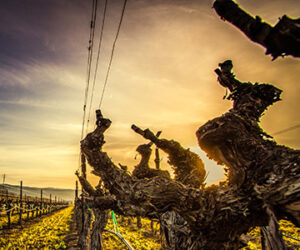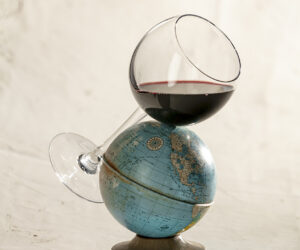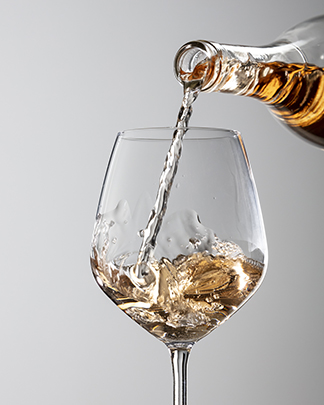
White winemaking as most of us understand it is infant technology. The fresh, lean whites that have come to populate store shelves and restaurant wine lists are made possible by the Atomic Era innovations of inert gas, sterile filtration, and easily-dosed sulfite preparations, to name a few. Seventy-plus years of tradition may seem substantial, but, when you measure it against the unabridged history of winemaking, it doesn’t amount to much.
Fact is, most white wines available today are fragile; absent modern technology, they’d be sitting ducks for a multitude of spoilage mechanisms. The quick-to-bottle, fruit-forward style that has come to dominate white winemaking requires that phenolic extraction be limited; in young wines, an abundance of tannin can sometimes lead to aromatic obscuration and rough texture — characteristics that are typically resolved via bulk aging. However, the absence of wine’s natural buffers against oxidative and microbial spoilage means that significant winemaker oversight and input are required to prevent disaster.
So were the white wines that preceded our era just plain faulty? Not exactly, but there’s an argument that many of them wouldn’t be considered white by today’s standards. They would, however, fit neatly within the newest category to grace bottle lists worldwide: Orange or amber wines.
So what is Orange Wine, Anyway?
In the simplest sense, orange wines are defined by one key fermentation parameter: Skin contact. Any winemaker can tell you that skin contact, also called maceration, is the identifying step in red and rosé wine production. But, if this step is applied to white grapes, the result is a wine with a deep amber or orange hue.
Orange wines are likely as old as winemaking itself, with the earliest evidence of their production in the Republic of Georgia. For millennia, Georgian winemakers have been macerating white grapes like Rkatsiteli, fermenting and aging in buried terracotta amphorae — traditional vessels known in Georgia as kvevri. This local style was nearly lost under Soviet occupation, as the desire for low-cost wines behind the Iron Curtain re-oriented the country’s wine industry toward high volume bulk products. A few intrepid Georgian winemakers managed to keep their ancestral tradition alive, and were able to revive it following the collapse of the USSR.
Georgia may be the ancestral home of orange wine, but winemakers along the Italian-Slovenian border are most responsible for the style’s renaissance. Though their region is more commonly associated with fresh, modern Pinot Grigio, the traditional Ramato interpretation of this and a range of other aromatic varieties has been fully embraced by some of the area’s most forward-thinking and celebrated vintners. Drawing inspiration from their success, wineries the world over have begun to incorporate orange wines into their portfolios.
Why Make Orange Wine?
Most winemakers have plenty of experience making conventional white wines, but fermenting white grapes on their skins remains an uncharted territory for many. Though the fermentation techniques involved are identical to those employed when producing red wine, there are some wrinkles when using grapes not usually processed this way. Is it really worth it? If you’ve made it this far, you may have guessed that the short answer is “yes” — any difficulties encountered while making orange wines are offset by their enhanced aromatic intensity, texture, and ageability.
While modern white wines are often highly aromatic, the olfactory potential of their skin-fermented counterparts is unrivaled. Terpenes, the potent organic compounds responsible for spicy and floral aromas, are typically in their highest concentrations in the tissues nearest a grape’s skins. In conventional white wine production, cold soaking is sometimes employed as a means of amplifying terpene content; carrying this skin contact through fermentation increases terpene extraction. Orange wines made from floral varieties can have some of the most complex noses of any wine you might encounter.
One of the more obvious organoleptic differences between orange and white wines is texture. Skin-fermentation in white grapes brings with it the same grip, weight, and richness expected in red wines. In white grape varieties where textural balance is difficult to achieve, extended maceration often goes a long way toward harmonizing overall mouthfeel.
What orange wines sometimes lack in early drinkability they make up in ageability. The phenolic compounds extracted via skin fermentation can take time to soften, but they’re also natural buffers against oxygen — one of the key ingredients in several wine spoilage mechanisms. A wine’s relationship to oxygen is complicated, to say the very least. Early in the winemaking process, dissolved oxygen is critical for fermentation health, color stability, and graceful tannin polymerization. As aging drags on, however, excess oxygen can damage aromatic compounds, flatten texture, and provide essential conditions for the proliferation of aerobic spoilage yeasts and bacteria. The naturally antioxidant phenolics extracted during extended maceration provide some protection against these common sources of spoilage, thereby extending the wine’s shelf life.
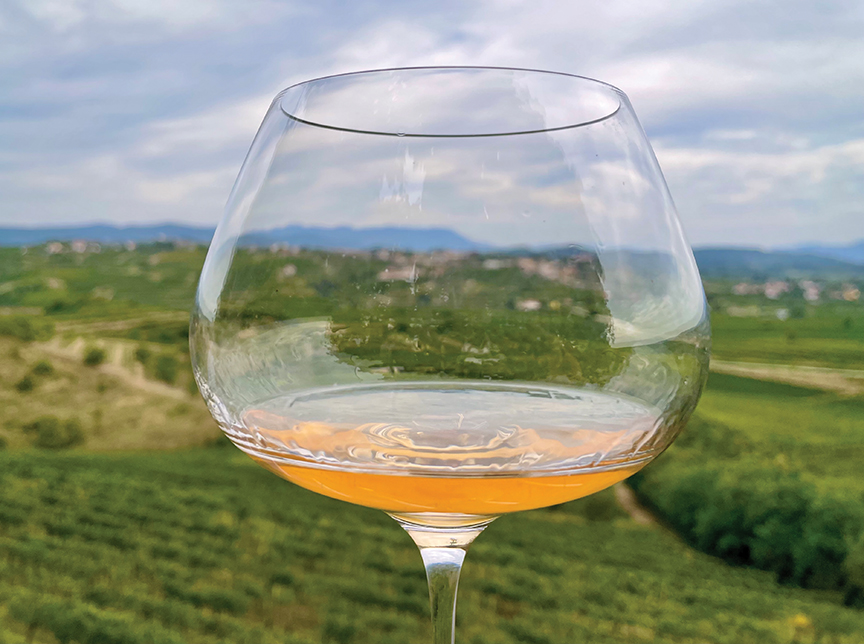
Bringing it Home: Producing Orange Wines in the Home Winery
Now that some of the unique and attractive attributes of orange wines have been enumerated, it’s time to talk about how they’re made, and, more specifically, how to make texturally-rich, aromatically-vibrant, age-worthy examples in the home winery. Home winemakers who have experience making red wines from whole fruit will recognize this process, but scaling it to grape varieties that aren’t traditionally used for this purpose presents some novel challenges. With careful attention to fruit sourcing, fermentation management, and aging strategy, the winemaker can deftly navigate said challenges to produce soulful wines with excellent cellaring potential.
Fruit Sourcing
The defining characteristic of orange wines is that they’re fermented on skins — this necessitates that they be made from whole fruit. Unfortunately, this is not a production style that is compatible with juice buckets or wine kits. Dealing with whole fruit brings its own challenges, but close consideration of a few key parameters can help the winemaker to maximize the potential of the grapes, making those challenges entirely worthwhile. Starting with suitable varieties and working with ripe, clean fruit are the foundation of any great orange wine, and winemakers who prioritize these factors will be set up for success at every step of the process.
Just about any white or pink grape variety may be used to make an orange wine, but some varieties are tailor-made for this style. Traditionally, vinifera varieties like Rkatsiteli, Pinot Grigio, and Friulano have been the favored grapes grown in orange wine’s ancestral hotbeds. However, as this tradition has spread from Georgia and Friuli, winemakers around the world have applied this production strategy to the white grapes present in their respective regions, often with tremendous results.
For winemakers looking to try orange wine production, Chardonnay is an excellent starting point. Even in white wine, Chardonnay is subjected to many classic red winemaking techniques like malolactic fermentation and oak aging; producing skin-fermented Chardonnay just adds another layer of complexity and allows a winemaker to ease into the orange wine category.
Floral varieties like Gewürztraminer and Viognier also have enormous potential as orange wines. Extended skin contact makes for more effective extraction of floral terpenes, which in turn makes for aromatically intense wines, bursting with complexity. Additionally, the increased phenolic extraction gained from this technique may help to address some of the off-balance phenolic issues commonly seen in aromatic varieties that are traditionally subjected to cold soaking.
While vinifera varieties have been used to deliberately produce orange wine for centuries, this category is one where hybrid grape varieties really shine. Aromatic hybrids like Traminette, Valvin Muscat, and LaCrescent are all capable of producing layered, complex orange wines. Even labrusca varieties like Catawba gain compelling levels of dimension when fermented on skins. One added benefit of using hybrids for orange wine production is their unique phenolic chemistry; tannins are often found in lower concentration in hybrid wines, allowing for less bulk aging prior to packaging.
Skin fermentation of white grapes requires slightly different ripeness parameters than conventional white wine production. In modern white winemaking, phenolic extraction is relatively limited, so the winemaker may make harvest decisions that prioritize bright acidity over full phenolic ripeness. If underripe grapes are used for orange winemaking, however, the coarse, undeveloped tannins may have a negative impact on both flavor and texture. One of the simplest ways to evaluate phenolic ripeness in grapes is to look at and chew the seeds: When ripe, the seeds will be brown, crispy, and easy to separate from the grape pulp; if the grapes aren’t ripe, their seeds will be yellow-green, hard to chew, and will often be contained in a pectin sac, independent of the rest of the grape flesh.
Fruit cleanliness is of paramount importance when producing orange wines. Vineyard infections like sour rot and Botrytis can negatively affect the finished wine. The oxidation and volatile acidity produced by these spoilage vectors are unpleasant from both aromatic and flavor standpoints. Additionally, Botrytis can oxidize and degrade polyphenols, damaging the texture and ageability of wines produced from infected fruit. In conventional white winemaking, the impact of these rots may be mitigated via careful press fractioning and juice fining, but skin fermentations do not afford the winemaker these options. Starting with clean must is, well, a must.
Fermentation Management
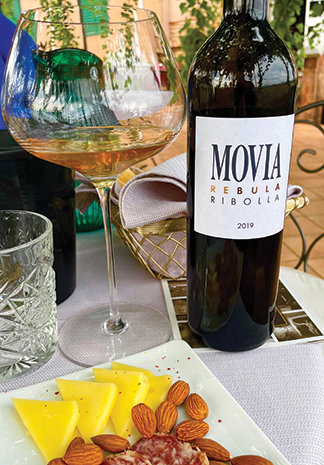
Once grapes have been selected and harvested, the focus of the orange winemaking process shifts to its characteristic skin fermentation. Skin fermentations require a high level of winemaker input, but elements of that input may be adjusted to suit the stylistic goals of the finished product. An orange wine’s style can be shaped by yeast strain selection, cap management, maceration length, and press fractioning.
Though orange wines are a staple of the natural wine community, more consistent, manageable fermentations can be had through the use of commercial yeasts. Commercial yeast strains have unique enzymatic activities that may be leveraged in order to reach the stylistic targets of the winemaker. A variety of commercial strains like Lalvin’s W15, ICV-GRE, ICV-D254, 71B-1122, and Anchor’s Exotics Mosaic are equally as effective in both white and red wine fermentations, so they’re natural fits for orange wine production. 71B-1122 and Exotics Mosaic (which isn’t available in increments below 250 g, unless you can find a shop that breaks it up) have the added benefit of malic acid metabolism; the acid profiles of orange wines are sometimes difficult to balance, and removing some malic acid via primary or malolactic fermentation goes a long way toward harmonizing the flavor and texture of the finished wine. Using commercial yeast also allows the winemaker to tailor fermentation parameters around the ideal temperature range and nutrient demand of the selected strain, thereby ensuring fermentation health and limiting reductive off-odors.
Once fermenting, the grape skins will float to the top of the fermenting vessel and form a cap, as in red wine production. Left unattended the cap will dry out, limiting extraction and presenting an excellent breeding ground for spoilage vectors like fruit flies. Regularly submerging the cap optimizes extraction and minimizes opportunities for contamination. This can be achieved in a home winery setting via regular punchdowns or stirring, breaking up, and wetting the skins. In some cases a rack and return — where the juice is removed from under the cap to a second vessel before being poured back onto the skins to resuspend them — may be employed to increase oxygen saturation and promote tannin polymerization.
The frequency of cap management actions has a direct impact on the composition of the wine, but a standard protocol of twice per day will help to limit the possibility of spoilage while increasing this frequency will improve extraction.
The amount of time that an orange wine spends on its skins has a direct effect on its flavor, aroma, and texture. Longer skin contact makes for greater extraction of flavor and aromatic compounds, but extending maceration also extends the scope of winemaker intervention and can also have implications for the amount of aging the wine will need to see before it’s ready to package and drink. A cap may continue to form on the top of the fermentation and will need to be managed for as long as it persists. If the winemaker is looking to produce a leaner, lighter, quicker-drinking wine, macerations may be limited to a week or less; if looking to produce a richer, more age-worthy wine, macerations may extend for several weeks or months.
Eventually, all orange wines need to be separated from their skins via pressing. The amount of pressure that is applied to achieve this has a profound influence on the texture of the wine. Wine extracted at low pressure generally exhibits fresher acidity and softer tannins than the richer, coarser wine extracted at higher pressures. The winemaker can employ press fractioning — limiting pressure or separating low and high pressure juice — and then blending press fractions as a way to shape textural balance prior to bulk aging.
Aging Strategy
Immediately post-pressing, orange wines are often texturally coarse and aromatically reductive, requiring bulk aging to soften and wake up prior to packaging. The stylistic goals of the winemaker will determine what length and type of aging is required to bring the wine into balance ahead of bottling. Additionally, the winemaker may decide to employ or avoid fining and/or filtration in pursuit of the desired style.
Bulk aging as it pertains to orange wine production is all about refining both texture and aroma; this is accomplished by managing the wine’s relationship to oxygen, which catalyzes tannin polymerization and reacts with reductive sulfur compounds to make them less apparent. The aging vessel type and time are both factors that can affect oxygen transfer. Aging in glass carboys, if they’re topped up appropriately, has the effect of excluding oxygen — perfect for fresher, quicker-to-drink wines, but also great for wines that will be kept in bulk for several months or years. Oak barrels or plastic polymer vessels like FlexTank will allow some oxygen transfer, helping to soften more tannic wines over time. Oak vessels may also contribute tannins that can flesh out mouthfeel and fill gaps in the wine, if necessary. The amount of time needed for aging really comes down to personal preference — the winemaker should taste the aging wine at regular intervals to evaluate its organoleptic properties, moving toward packaging when the aromatic, flavor, and textural balances are judged to be in harmony.
Fining and filtration may also be used to affect the aging process and shape the profile of an orange wine. Proteinaceous fining agents like gelatin or egg white may be used to refine tannin structure quickly, and may have the added benefit of clarification. Filtration is also an effective means of achieving visual clarity and textural fine-tuning in these wines. However, fining and filtration may also have detrimental effects on mouthfeel and complexity, robbing wines of their natural structure and removing an opportunity to pick up additional weight from lees contact. As texture is one of the defining features that distinguishes orange wines from their white counterparts, there is a strong argument to be made for avoiding these steps entirely. There is a strong commercial precedent for unfined, unfiltered orange wines that exhibit some haze in the bottle; the necessity of clarification is purely a matter of winemaker preference.
Conclusions
As is often the case in the wine world, the renaissance of orange wines reminds us that pre-modern winemakers don’t always get the credit they deserve. In the absence of the technologies that many of us take for granted, they managed to produce complex, soulful, age-worthy wines from unexpected grape varieties. Guided simply by intuition and tradition, they understood their white grapes in a way that modern winemakers are just now rediscovering.
With today’s orange wines gaining commercial success and critical acclaim, it’s only natural that home winemakers should want to try their hand at skin fermenting white grapes. Any home winery that is set up to crush and press whole fruit already has all of the necessary tools to explore this alluring and ancient winemaking technique. With proper attention to fruit selection, fermentation, and aging, experienced home winemakers can produce layered wines that will last and develop for many years.
So if you’re looking to try something new that isn’t really new, give orange wine a try. It’ll fill you with a renewed appreciation for the winemakers of the past and a new perspective on the white grape varieties you already know. You don’t need a fancy amphora to start; just white grapes, some elbow grease, attention to a few key details, and a willingness to let your senses be your guide.



